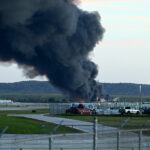BP Plc wasn’t prepared for a blowout at its deep-water Macondo well in the Gulf of Mexico, a safety expert who studied the 2010 oil spill told a judge who is assessing how well the company reacted to the disaster.
BP didn’t spend money on deepwater source control before the April 20, 2010, blowout and neglected process safety management, Robert Bea, a retired engineering professor from the University of California, Berkeley, who was called as a plaintiffs’ witness testified yesterday at the nonjury trial over the efforts to contain the spill.
“You can never forecast and predict everything that is important,” Bea told U.S. District Judge Carl Barbier in New Orleans. “‘I don’t know what to do’ is never an excuse in mature process safety management.”
Plaintiffs suing BP over the disaster are asking Barbier to find the company failed to properly prepare for a deepwater blowout or respond quickly enough once it occurred. His decisions in this phase of the case, over the size of the spill and efforts to contain it may add or subtract billions of dollars from BP’s ultimate bill for the incident.
The company didn’t vary from industry standards in preparing for source control of a deepwater blowout, Bea acknowledged under cross examination from a BP lawyer yesterday. Bea said in a pretrial report that BP’s pre-disaster plans to mitigate a failure were inadequate.
Mike Brock, a lawyer for London-based BP, asked Bea yesterday if the company’s source control plan was the same as those by rivals Shell Oil Co. and Exxon Mobil Corp. Bea had earlier praised plans by BP’s competitors.
‘Cut-and-Paste’
“It looks like they were all written by the same group using cut-and-paste technology,” Bea replied. The industry seemed to handle blowouts on a “case-by-case basis,” he said.
The blowout of BP’s Macondo well off the coast of Louisiana in April 2010 killed 11 people aboard the Deepwater Horizon drilling rig and set off the largest offshore oil spill in U.S. history. The accident sparked hundreds of lawsuits against BP, as well as Transocean Ltd., owner of the rig that burned and sank, and Halliburton Co., which provided cement services for the project.
In the first phase of the case, also heard by Barbier without a jury, the judge considered evidence of fault for the disaster and whether any of the companies’ actions in causing the blowout and subsequent spill reached the level of gross negligence. A finding of gross negligence would trigger higher fines for BP and punitive damages for all three defendants.
Phase two, which began Sept. 30, covers the size of the spill and BP’s efforts to contain it. Decisions in phase two of the trial would mean billions of dollars to BP.
40 Percent
A finding by Barbier supporting BP’s assessment that the spill was 40 percent smaller than the government’s estimate might shave as much as $7.5 billion from the $18 billion in maximum fines the company faces under the U.S. Clean Water Act.
A finding that BP’s actions let the spill continue longer than it might have may save its co-defendants, Transocean Ltd. and Halliburton Co., as much as 70 percent of any judgments against them.
Plaintiffs suing BP, including the states of Alabama and Louisiana, claim that the company wasn’t ready for the blowout. The well was finally capped on July 15, 2010, through the use of a device called a capping stack. The plaintiffs claim BP should have had this device available before the blowout.
The co-defendants, Transocean and Halliburton, have aligned with the plaintiffs in alleging that BP delayed capping the well by misrepresenting the size of the spill. An early attempt to cap the well, called Top Kill, was doomed to failure because the flow rate was too high, the co-defendants and plaintiffs contend.
Monday ‘Quarterbacking’
BP has countered that it did everything it could to stop the flow of oil as quickly as possible. Critics who suggest otherwise are engaging in “Monday morning quarterbacking at its worst,” Brock said in his opening statement Sept. 30.
BP was attempting to balance its desire to cap the well with the “guiding principle” not to make the situation worse, company executive James Dupree testified yesterday. Dupree, chief operating officer of resource development, led BP’s source control efforts after the well blew.
“We were very intent on not making the situation worse,” Dupree said.
“What do you mean by, ‘Do not make things worse?’” BP lawyer Hariklia Karis asked him.
“We didn’t want to lose options to kill the well,” he said.
Rejected Method
BP rejected a proposed method, called BOP-on-BOP, which would have landed a second blowout preventer onto the lower portion of the failed Deepwater Horizon blowout preventer, because it would have precluded using an alternate solution if that effort failed, the company said in court papers. BP instead tried the Top Kill approach.
“BOP on BOP was not ready,” Dupree testified yesterday. There were “several engineering issues” with the Macondo well that made the BOP on BOP a problematic method, he said.
He was worried about the impact of lowering a massive blowout preventer weighing several hundred tons onto the disabled BOP, he said.
“I was concerned about the weight of the BOP on top of the BOP,” he said, adding later: “There were particulars and unknowns down at the bottom of the well.” BP worried about fracturing pathways to the sea floor, he said.
Spill Response
The length of the spill response shows BP wasn’t prepared for source control, plaintiffs’ witness Ed Ziegler, a veteran oil and gas operator, testified yesterday. Ziegler, a consultant with Safety United Inc. in Houston, said he had drilled thousands of wells worldwide.
“The requirement is that the source flow be abated as soon as possible,” Ziegler said under questioning by Halliburton lawyer Prescott W. Smith. “BP had a well that flowed for 87 days,” Ziegler said.
The well could have been capped in seven days if the company had invested in a source control plan, Ziegler said. “They spent zero dollars on source control.”
A blowout preventer, or BOP, could have been assembled “with off-the-shelf” equipment in several days and the cap installed during a week’s time with one day to spare for “contingency,” he said.
BP kept changing plans to stanch the Macondo well and even changed drilling ships as staging areas, Ziegler testified. “By the time they capped the well in mid-July it was their sixth different plan.”
‘Changing Plans’
He said none of the previous plans — such as Top Kill — were ever finished. “They kept changing plans in mid-stream.”
On cross examination, BP lawyer Karis expressed incredulity, starting with Ziegler’s credentials.
“You hold yourself out in many fields,” Karis told the witness, including ergonomics, road construction, lightning on oil rigs, hospital safety, accident reconstruction, ventilation systems and circular saws.
Ziegler said he was an expert in oil-field safety and that weather-permitting, he could have capped the well in a week.
BP asked Barbier after the trial adjourned today to throw out the claims that the company’s preparations for a spill were inadequate and its response afterward extended the flow of oil.
“The aligned parties have not proven that any BP conduct was negligent, let alone grossly so,” the company’s lawyers said in a court filing, seeking judgment for BP as a matter of law.
The case is In re Oil Spill by the Oil Rig Deepwater Horizon in the Gulf of Mexico on April 20, 2010, 10-md-02179, U.S. District Court, Eastern District of Louisiana (New Orleans).
(Editors: Peter Blumberg, Michael Hytha)
Was this article valuable?
Here are more articles you may enjoy.

 Sins of Policy Interpretation: A Call to Repentance
Sins of Policy Interpretation: A Call to Repentance  Death Toll From UPS Plane Crash up to 13, Airport Reopened
Death Toll From UPS Plane Crash up to 13, Airport Reopened  US Airlines Cut Flights, With More Cancellations into Next Week
US Airlines Cut Flights, With More Cancellations into Next Week  Research Report Shows Cyber Insurance Growing 15% in 2026 on AI And Data Threats
Research Report Shows Cyber Insurance Growing 15% in 2026 on AI And Data Threats 